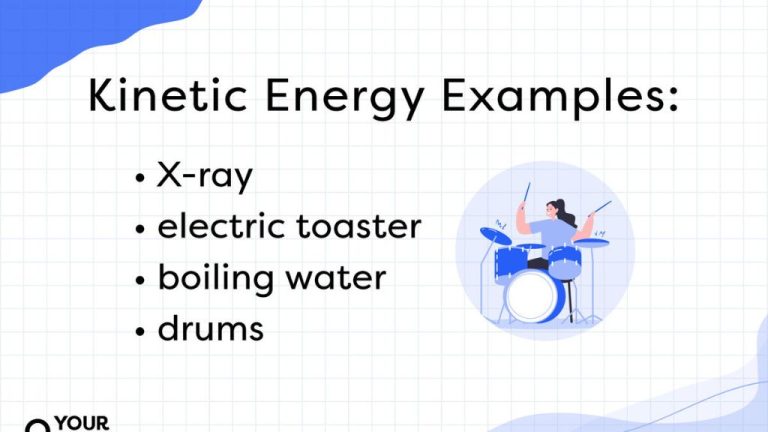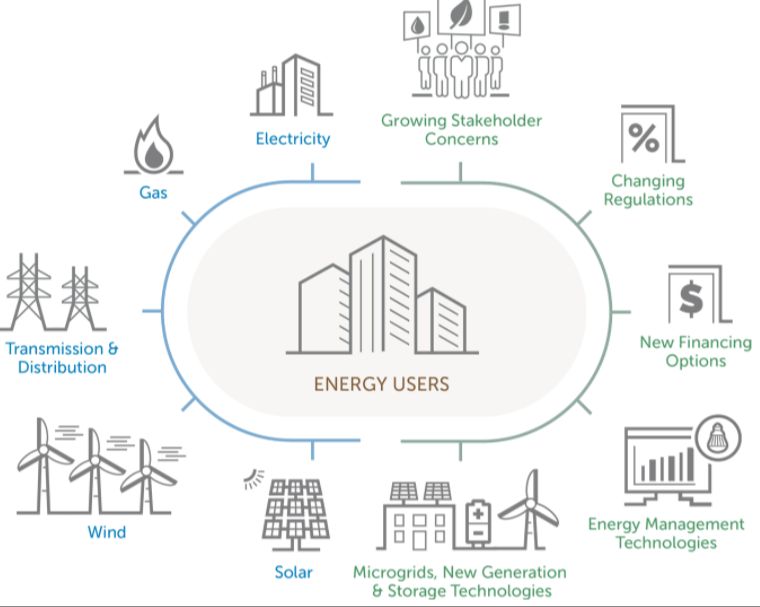What Is Energy Definition In Science?
Energy is the ability to do work or cause change. In science, energy is defined as the property of objects or systems that allows them to do work on other objects or systems. Energy comes in many different forms such as heat, light, motion, and more.
The concept of energy is extremely important in all fields of science. It helps explain how living things grow and move, how chemical reactions occur, and how stars produce light. The conservation of energy is one of the most fundamental laws in physics, stating that energy cannot be created or destroyed – it can only change from one form to another.
Understanding energy is key to understanding our universe. It allows scientists to trace where energy comes from, how it changes into different forms, and where it ultimately goes. Having a clear definition of energy is crucial for designing new technologies, studying biological processes, and modeling Earth’s climate.
Forms of Energy
Energy exists in many different forms that can be categorized into several major types. Here are the main forms of energy:

- Kinetic Energy – The energy possessed by an object due to its motion. The faster an object moves, the more kinetic energy it has.
- Potential Energy – The stored energy an object has due to its position or chemical composition. There are several types of potential energy including gravitational, elastic, and chemical potential energy.
- Thermal Energy – The internal energy of an object due to the kinetic energy of its atoms and molecules. The higher the temperature of an object, the more thermal energy it possesses.
- Chemical Energy – The energy stored in the bonds between atoms that make up a chemical compound. Foods, fuels, and batteries contain stored chemical energy that is released during chemical reactions.
- Nuclear Energy – The energy that binds protons and neutrons in an atomic nucleus. Nuclear energy can be released when atomic nuclei are combined or split apart.
- Electromagnetic Energy – Energy that travels through space via electromagnetic waves. Examples include radio waves, microwaves, infrared radiation, visible light, ultraviolet rays, and gamma rays.
Energy Transformation
Energy can transform from one form to another during interactions between systems. For example, when a moving car suddenly brakes, the car’s kinetic energy transforms into heat and sound energy from the friction of the brakes. Some other examples of energy transformations include:
– Chemical energy in food transforming into kinetic energy as an animal moves
– Electrical energy in power lines transforming into light and heat energy in a light bulb
– Nuclear energy in radioactive isotopes transforming into thermal energy as they decay
– Mechanical energy of flowing water transforming into electrical energy at hydroelectric dams
– Solar energy transforming into thermal energy as it heats surfaces on Earth
The different forms of energy can transform back and forth continuously. However, the total amount of energy remains constant during any transformation according to the law of conservation of energy. Energy transformations occur constantly around us, powering processes in biological, chemical, physical, electrical, mechanical and nuclear systems.
Potential Energy
Potential energy is the stored energy of position or configuration possessed by an object. Position refers to an object’s height or depth or other spatial relation. Configuration refers to the arrangement of parts or the relative positions of the parts of an object. There are several forms of potential energy:
- Gravitational potential energy: This is energy stored due to elevation. For example, a rock sitting on the edge of a cliff has potential energy due to its position in the Earth’s gravitational field. As gravity pulls it down, it loses gravitational potential energy and gains kinetic energy.
- Elastic potential energy: When objects are compressed or stretched, they store elastic potential energy. For example, when a spring is compressed or stretched from its resting position, it exerts an opposing force as it tries to return to its original shape. This energy is released when the spring recoils.
- Chemical potential energy: Molecules and atoms have potential energy in the form of chemical bonds between atoms. Chemical reactions involve changes in chemical potential energy. The energy released when the bonds break is equal to the energy required to form the bonds originally.
In general, potential energy transforms into kinetic energy when released. An object gains potential energy when work is done to it against a force, increasing its position or changing its configuration. This stored energy is then released as kinetic energy when the opposing force acts.
Kinetic Energy
Kinetic energy is the energy of motion. An object that has motion – whether it is vertical or horizontal motion – has kinetic energy. The amount of kinetic energy depends on two variables: the mass (m) of the object and the velocity (v) of the object. The kinetic energy (KE) of an object can be calculated using the following formula:
KE = 1/2 mv2
As the formula shows, if the mass or velocity increases, the amount of kinetic energy also increases. Kinetic energy and velocity are directly proportional – as velocity increases, kinetic energy increases. Kinetic energy and mass are also directly proportional – as mass increases, kinetic energy increases.
Some examples of kinetic energy in action include:
- A moving train has kinetic energy due to its large mass and velocity.
- A baseball hit by a baseball bat gains kinetic energy from the movement of the bat.
- Wind has kinetic energy due to the motion of the air molecules.
- Flowing water in a river has kinetic energy due to its mass and velocity.
In each example, the object or substance has energy due to its motion. This motion energy is kinetic energy. The faster or more massive something is, the more kinetic energy it possesses.
Thermal Energy
Thermal energy, also known as heat energy, is the energy contained within a system due to the motion of particles (atoms and molecules). The higher the temperature of a substance, the greater the thermal energy because the particles move faster and have more kinetic energy. Thermal energy is directly related to the kinetic energy of the particles that make up a substance.
As an object or system absorbs thermal energy, its temperature rises because its particles gain kinetic energy and move faster. Heat always moves from a hotter object to a colder object as the particles interact until thermal equilibrium is reached. Examples of thermal energy transfer include touching a hot stove, radiation from the sun warming the earth, or boiling water on a stove. Anything that generates warmth has thermal energy.
Thermal energy can be measured in joules (J), calories (cal), or British thermal units (BTU). It is an important form of energy in fields like thermodynamics and engineering. Understanding thermal energy is crucial for designing efficient heating, refrigeration, and energy generation systems.
Chemical Energy
Chemical energy is the energy stored in the bonds between atoms and molecules. It is the energy that holds these particles together. During chemical reactions, the energy stored in the bonds between atoms is either released (exothermic reactions) or absorbed (endothermic reactions). The amount of energy stored in the bonds of a substance depends on the types of atoms, the types of bonds, and the molecular structure.
Some examples of chemical energy include:
- Energy stored in the molecules of food, gasoline, wood, and other fuels. When these substances undergo combustion or cellular respiration, chemical energy is released.
- Energy stored in batteries. Chemical reactions in batteries convert chemical energy into electrical energy.
- Energy from ATP molecules. ATP provides the chemical energy that powers many biochemical reactions in cells.
- Nuclear energy from fission and fusion reactions. Nuclear reactions involve changes in atomic nuclei and release enormous amounts of chemical energy.
In summary, chemical energy exists at the atomic and molecular level in the bonds between atoms. Chemical reactions can release this energy for useful work while forming new bonds.
Nuclear Energy
Nuclear energy is the energy stored in the nucleus of an atom. Atoms are the basic units that make up matter in the universe. The nucleus is the core of the atom that contains protons and neutrons. These subatomic particles have immense energy holding them together.
There are two types of nuclear reactions that can produce energy – nuclear fusion and nuclear fission.
Nuclear fusion occurs when two light atomic nuclei combine to form a heavier nucleus. This process releases an enormous amount of energy. The primary example of nuclear fusion is in stars, including our sun. The high pressure and temperature at the core of stars provide the conditions for fusion to occur. Hydrogen atoms fuse together to form helium, releasing energy that powers the star.
Nuclear fission occurs when a heavy atomic nucleus splits into two or more lighter nuclei. Nuclear power plants use fission reactions to heat water and produce steam that spins a turbine to generate electricity. Uranium and plutonium are commonly used as nuclear fuels.
Nuclear energy has the highest density of any energy source, so it can produce abundant power from very small amounts of fuel. However, it also generates radioactive waste that must be safely contained. Nuclear energy is considered a low-carbon energy source since operating nuclear plants themselves do not release greenhouse gases.
Electromagnetic Energy
Electromagnetic energy is a form of energy that is related to the electric and magnetic fields and how they interact with each other and with matter. It is one of the fundamental forms of energy. Some key things to know about electromagnetic energy:
– Electromagnetic energy consists of electromagnetic waves or particles called photons. Photons carry electromagnetic energy.
– Examples of electromagnetic waves are radio waves, microwaves, infrared radiation, visible light, ultraviolet radiation, x-rays and gamma rays. They have different frequencies and wavelengths but all travel at the speed of light.
– Electromagnetic energy is generated whenever electric charges accelerate – so things like electricity, magnetism and light involve electromagnetic energy.
– Examples of electromagnetic energy in everyday life include light from the sun, light bulbs, radio/TV signals, cell phones, x-rays and microwaves.
– Electromagnetic energy interacts with matter by being absorbed and emitted by atoms and molecules. This underlies technologies like solar cells, cameras, radios, lasers and more.
– Photons carry momentum as well as energy. Pressure exerted by light is an example of the momentum of electromagnetic radiation.
Conservation of Energy
The law of conservation of energy is one of the fundamental principles of physics. It states that energy can neither be created nor destroyed – it can only be transformed from one form to another. This is known as the first law of thermodynamics.
For example, when an object falls, its potential energy is transformed into kinetic energy. The total amount of energy before and after the fall remains constant, but the energy has changed form. When gasoline is burned in a car’s engine, the chemical energy stored in the gasoline’s molecular bonds is converted into thermal energy and mechanical energy to move the car forward. Again, the total amount of energy in the system remains the same.
The universe contains a fixed amount of energy in different forms. Every change or transformation between these forms represents a transfer of energy, but never a net gain or loss. This conservation of energy is a foundational concept in our understanding of the physical world.
Other examples of energy transformation while conserving the total energy in a system include:
- Solar energy being converted to chemical energy through photosynthesis
- Chemical energy in food being converted to thermal energy and work through cellular respiration
- Mechanical energy in a wind turbine converted to electrical energy
- Chemical energy in batteries converted to light and heat energy
The law of conservation of energy will always hold true, no matter the type of energy transformation taking place. The total amount of energy in a closed system remains fixed.







